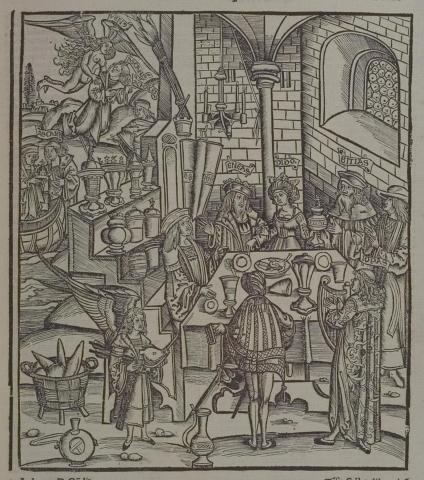Annotations
In this image, Dido has put on a grand banquet for Aeneas and his men. The feast takes place in the royal banquet hall (631-642). Vergil describes a palace filled with gold and silver wares and purple fabrics (639-42), and though Vergil does not describe the architecture, one might picture spacious marble halls. Instead, Brant sets the scene in the kind of palace that would be most common in 16th-century Germany. Dido's banquet hall has thick brick walls and a small decorative column. Inside the banquet hall, Aeneas and Dido are seated at the head of the table; Bitias, one of Dido's courtiers, is seated to the right of her. To the left of Aeneas is a set of shelves with ancestral trophies, perhaps a representation of the deeds of Dido's ancestors (640-3). The feast is finished and Dido is asking Aeneas to tell his story (752-6). At the foot of the table, Iopas the bard holds a lyre (740-1). Outside the hall, several scenes are shown at once. Ascanius waits in the ship for news (643-6). Achates stands on the shore and calls to Ascanius. Between the boat and Achates, winged Venus flies off with Ascanius. Her son, Eros, stands in the banquet hall disguised as Ascanius, bearing gifts (695-6) and holding two arrows under his arm. Venus has sent Eros in place of Ascanius to awake in Dido's heart a passionate desire for Aeneas (673-88). (Katy Purington)
Woodcut illustration from the “Strasbourg Vergil,” edited by Sebastian Brant: Publii Virgilii Maronis Opera cum quinque vulgatis commentariis expolitissimisque figuris atque imaginibus nuper per Sebastianum Brant superadditis (Strasbourg: Johannis Grieninger, 1502), fol. 151r, executed by an anonymous engraver under the direction of Brant.


Sebastian Brant (1458–1521) was a humanist scholar of many competencies. Trained in classics and law at the University of Basel, Brant later lectured in jurisprudence there and practiced law in his native city of Strasbourg. While his satirical poem Das Narrenschiff won him considerable standing as a writer, his role in the transmission of Virgil to the Renaissance was at least as important. In 1502 he and Strasbourg printer Johannes Grüninger produced a major edition of Virgil’s works, along with Donatus’ Life and the commentaries of Servius, Landino, and Calderini, with more than two hundred woodcut illustrations. (Annabel Patterson)